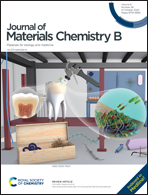Improving the photothermal therapy efficacy and preventing the surface oxidation of bismuth nanoparticles through the formation of a bismuth@bismuth selenide heterostructure†
Abstract
Bismuth (Bi) nanoparticles (NPs) are emerging as promising photothermal agents for computed tomography imaging-guided photothermal therapy. However, it is challenging to improve their photothermal conversion efficacy and prevent their oxidation. Herein, Bi@bismuth selenide (Bi2Se3) core@shell NPs were designed and fabricated for improving the photothermal performance due to the staggered energy levels between Bi and Bi2Se3. With near-infrared light irradiation, both the materials could be excited to generate hot carriers due to their extremely narrow bandgaps. The hot electrons would transfer to the conduction band of Bi2Se3 and the hot holes to the valence band of Bi, leading to the effective separation of hot carriers. Then, these hot electrons and holes would recombine nonradiatively at the interface of Bi and Bi2Se3 and produce more phonons, resulting in an enhanced photothermal conversion efficacy. Moreover, the presence of Bi2Se3 on the surface of Bi NPs could prevent Bi from surface oxidation due to the higher stability of Bi2Se3. In fact, Bi@Bi2Se3 NPs showed excellent biocompatibility and photothermal therapeutic efficacy against cancer cells.



 Please wait while we load your content...
Please wait while we load your content...